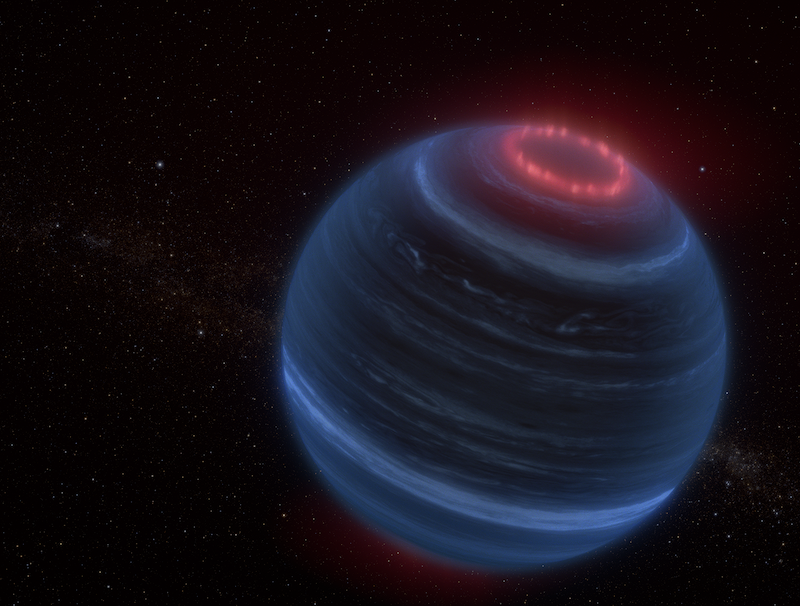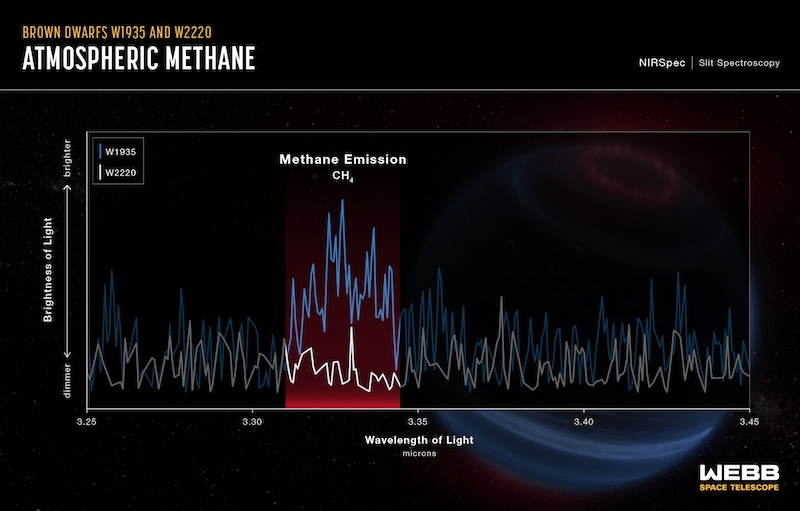
- Brown dwarfs are star-planet hybrid objects, too massive to be called ordinary planets, but not massive enough to shine as stars do.
- Astronomers have detected methane emission from a brown dwarf for the 1st time, meaning methane that is emitting light instead of absorbing it.
- Researchers say that auroras in the brown dwarf’s atmosphere may be creating the methane emission. They also think a moon orbiting the brown dwarf might play a role.
Methane is common on brown dwarfs, which are objects more massive than planets but less massive than stars. Methane on brown dwarfs is known to absorb light, so astronomers typically can’t detect it in visible light. But now, scientists say they have detected methane on a brown dwarf that is glowing in infrared light. In other words, the methane is emitting light instead of absorbing it. And that’s puzzling and unexpected.
Researchers at the American Museum of Natural History said on April 17, 2024, that they used the Webb space telescope to find the bright methane emission on the brown dwarf W1935. This object is located 47 light-years from Earth.
They spoke of their surprise at finding the bright methane on such a relatively cold body as a brown dwarf. The researchers said that auroras might be causing this methane emission.
The research team published their new peer-reviewed paper in Nature on April 17, 2024.
Methane emission on a cold brown dwarf surprises astronomers
Even though methane is typically abundant on brown dwarfs, astronomers don’t visibly see it in their atmospheres. That’s because it absorbs light rather than emits it. So seeing the methane signature in infrared on W1935 was a surprise. Plus, brown dwarfs are relatively cool; the temperature on W1935 is only about 400 degrees Fahrenheit (200 degrees Celsius). That’s hot by human standards, but cold compared to stars.
The researchers were studying 12 different brown dwarfs when they made the discovery. W1935 was the only one emitting methane. But why?
Jackie Faherty at the American Museum of Natural History led the new study. She said:
Methane gas is expected in giant planets and brown dwarfs but we usually see it absorbing light, not glowing. We were confused about what we were seeing at first but ultimately that transformed into pure excitement at the discovery.
Every time an astronomer points JWST at an object, there’s a chance of a new mind-blowing discovery. Methane emission was not on my radar when we started this project but now that we know it can be there and the explanation for it so enticing I am constantly on the look-out for it. That’s part of how science moves forward.

Temperature inversion and auroras on W1935
The methane emission wasn’t the only surprise. When the researchers did computer modeling of the brown dwarf’s atmosphere, they found evidence for a temperature inversion. Normally, an atmosphere gets cooler the higher the altitude. But in an inversion, it gets warmer instead. The phenomenon can happen on planets, since their host stars warm their atmospheres. But brown dwarfs aren’t planets, and W1935 doesn’t orbit a star. It’s isolated in deep space. So how could a temperature inversion occur? As co-author Ben Burningham at the University of Hertfordshire noted:
We were pleasantly shocked when the model clearly predicted a temperature inversion. But we also had to figure out where that extra upper atmosphere heat was coming from.
So how does this happen on W1935? Our own solar system planets Jupiter and Saturn may provide the answer: auroras. These giant planets have both methane emissions and temperature inversions. They also have auroras. Same as on Earth, the auroras come from high-energy particles from the sun hitting the planets’ magnetic fields. This creates heat and auroras in the planets’ upper atmospheres.
Does W1935 have a moon?
But scientists aren’t sure yet how auroras on W1935 would be generated, since it has no star and therefore no solar wind containing energetic particles. There is, however, another intriguing possible cause.
Both Jupiter and Saturn have moons that also eject material into space, Jupiter’s volcanic moon Io and Saturn’s ocean moon Enceladus in particular. That material helps enhance the auroras on both planets. So, could W1935 have a moon of its own? It’s an exciting, if still unproven, possibility.
If W1935 does have auroras, they wouldn’t be the first ones discovered on a brown dwarf. On July 29, 2015, astronomers detected auroras on the brown dwarf LSR J1835+3259. And in 2018, astronomers found auroras on a rogue planet, SIMP J01365663+0933473. Rogue planets also do not orbit stars. Instead, they wander through space alone.
Those findings, plus W1935, show that auroras are probably quite common, not only on planets orbiting a star, but on brown dwarfs and rogue planets as well.
Bottom line: For the 1st time, astronomers have found glowing methane on a brown dwarf. The researchers say that auroras in the brown dwarf’s atmosphere may cause it.
Source: Methane emission from a cool brown dwarf
Via American Museum of Natural History (EurekAlert!)
Read more: Astronomers find weird rogue world with wild auroras











